The Intel Skylake Mobile and Desktop Launch, with Architecture Analysis
by Ian Cutress on September 1, 2015 11:05 PM ESTThe Claims
As with any launch, there are numbers abound from Intel to explain how the performance and experience of Skylake is better than previous designs as well as the competition.
As with Haswell and Broadwell, Intel is implementing a mobile first design with Skylake. As with any processor development structure the primal idea is to focus on one power point as being the most efficient and extend that efficiency window as far in either direction as possible. During IDF, Intel stated that having an efficiency window from 4.5W to 91W is a significant challenge, to which we agree, as well as improving both performance and power consumption over Broadwell at each stage.
Starting at 4.5W, we spoke extensively with parts of Intel at IDF due to our Broadwell-Y coverage. From their perspective Broadwell-Y designs were almost too wide ranging, especially for what is Intel’s premium low-power high performance product, and for the vendors placing it in an ill-defined chassis far away from Intel’s recommended designs gave concern to the final performance and user experience. As a result, Intel’s guidelines to OEMs this generation are tightened so that the designers looking for the cheaper Core M plastic implementations can tune their design to get the best out of it. Intel has been working with a few of these (both entry Core M and premium models) to enact the user experience model.
Overall however, Intel is claiming 40% better graphics performance for Core M with the new Generation 9 (Gen9) implementation, along with battery saving and compatibility with new features such as RealSense. Because Core-M will find its way into products from tablets to 2-in-1s and clamshells, we’ve been told that the Skylake design should hit a home-run against the best-selling tablets in the market, along with an appropriate Windows 10 experience. When we get units in to review, we will see what the score is from our perspective on that one.
For the Skylake-Y to Skylake-U transition (and in part, Skylake-H), Intel is claiming a 60% gain in efficiency over Haswell-U. This means either 60% less active power during media consumption or 60% more CPU performance at the same power (measured by synthetics, specifically SPECint_base_rate2006). The power consumption metrics comes from updates relating to the Gen9 graphics, such as multi-plane overlay and fixed-function decoders, as well as additional power/frequency gating between the unslice and slices. We will cover this later in the review. The GPU itself, due to the new functionality, is claiming 40% better graphics performance for Core M during 3DMark synthetic tests.
While not being launched today, Intel’s march on integrated graphics is also going to continue. With the previous eDRAM parts, Intel took the crown for absolute IGP performance from AMD, albeit being in a completely different price band. With Skylake, the introduction of a 4+4e model means that Intel’s modular graphics design will now extend from GT1 to GT4, where GT4e has 72 execution units with 128MB of eDRAM in tow. This leads to the claim that GT4e is set to match/beat a significant proportion of the graphics market today.
Back in our Skylake-K review, we were perhaps unimpressed with the generational gain in clock-for-clock performance, although improved multi-threading and frequency ranges helped push the out-of-the-box experience. The other side of that performance is the power draw, and because Skylake is another mobile-first processor, the power aspect becomes important down in mobile devices. We will go through some of these developments to improve power consumption in this article.


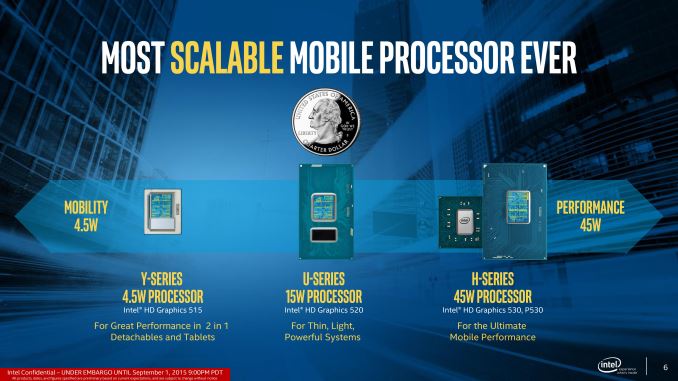
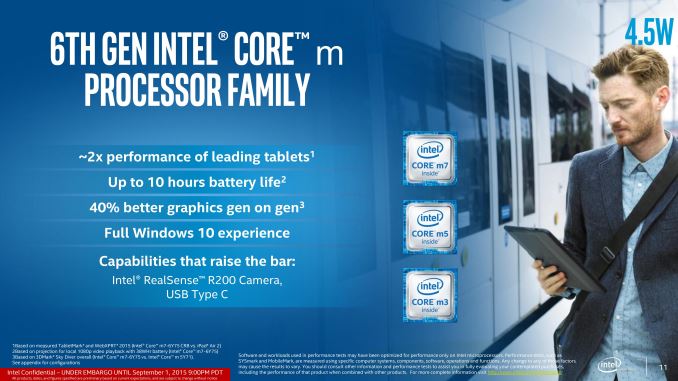
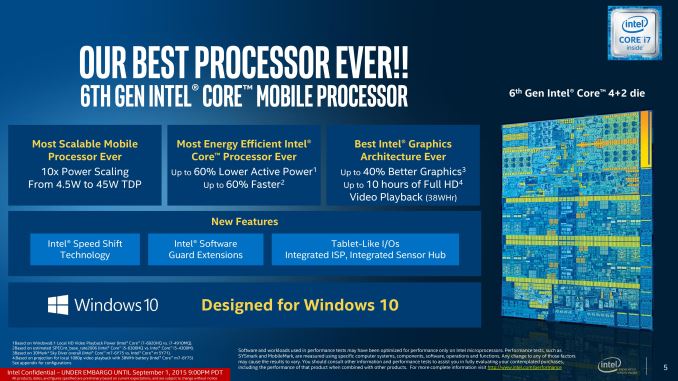
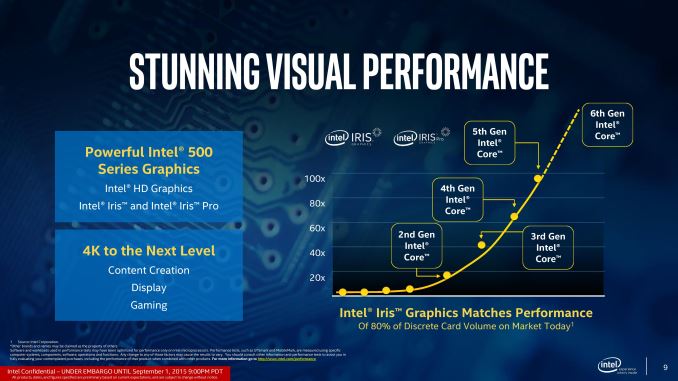
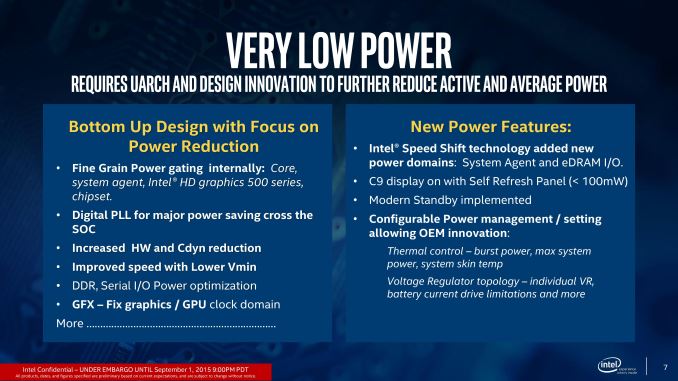








173 Comments
View All Comments
Le Geek - Wednesday, September 2, 2015 - link
Anything>>muchMrSpadge - Wednesday, September 2, 2015 - link
Well, for me the mobile quad's are totally uninteresting, be it i5 or i7. I'm rather interested in what you can get out of the 6700 iwth a Z170 board.Anyway, I second the request for an efficiency investigation. The 6700K started at insanely high stock voltages, so now onder it's not better than Haswell in this regard. AT also showed some numbers with optimal core voltage, but those start at 4.3 GHz and 1.20V. Which says nothing about any of the other chips, even in stock configurations (i.e. without undervolting).
dtgoodwin - Wednesday, September 2, 2015 - link
I also add my request. Based on Intel's comments, those tests likely need to be redesigned to approximate real world usage, not user tasks, then recorded and played back as fast as possible. I'd love to see efficiency from typical desktop usage, gamer, home theater, and "enthusiast". I'm sure you have several users that recordings could be taken from and played back to simulate these. Yes, the tests would take longer to perform, but it appears that's going to be a requirement to achieve accurate efficiency tests at this point.MrSpadge - Wednesday, September 2, 2015 - link
Measuring response times might be crucial for such tests, as the throughput might not be the most important metric any more. All tasks will have finished before the end of the benchmark, if played back slowly enough.vred - Wednesday, September 2, 2015 - link
"Secret source" = "secret sauce"?jjj - Wednesday, September 2, 2015 - link
Hard to care at this point given how little they offer and at what prices.The core does seem to be rather big and far too big for low W- perf per area is very very low there. Core M is still insanely priced given how little it does. Was wondering if they'll do a hard price cut ahead of A72 SoCs since at that point it will be a lot easier for folks to realize how absurd Intel's pricing is..
A few days ago noticed a little board with a quad A7, 1GB RAM and plenty of connectors for just 15$. That kind of computing device makes you wonder about where the world would be if we weren't stuck on Wintel. The premium this monopoly adds to PCs is heartbreaking at this point. At least in mobile things are ok for now.
extide - Wednesday, September 2, 2015 - link
Core m is on the order of 10x the performance of a Quad A7. Core m is also a pretty small die, it is a similar die size to mobile SoC's. Not sure what you are talking about ... it's a different product for a different price.bji - Wednesday, September 2, 2015 - link
I'm pretty sure Intel intentionally gimped the thermal performance with inferior TIM underneath the heat spreader. I believe this is a ploy to allow them to release a part with improved TIM some time down the road as a new, higher clocking revision. I think this is a way to gate performance intentionally so that the can sell essentially the same part over several releases.Without significant competition from AMD, this is the kind of thing that Intel can unfortunately get away with.
bji - Wednesday, September 2, 2015 - link
http://www.overclock.net/t/1568357/skylake-delidde...This thread gives good evidence that the part would clock much better with better TIM.
0razor1 - Wednesday, September 2, 2015 - link
Second that